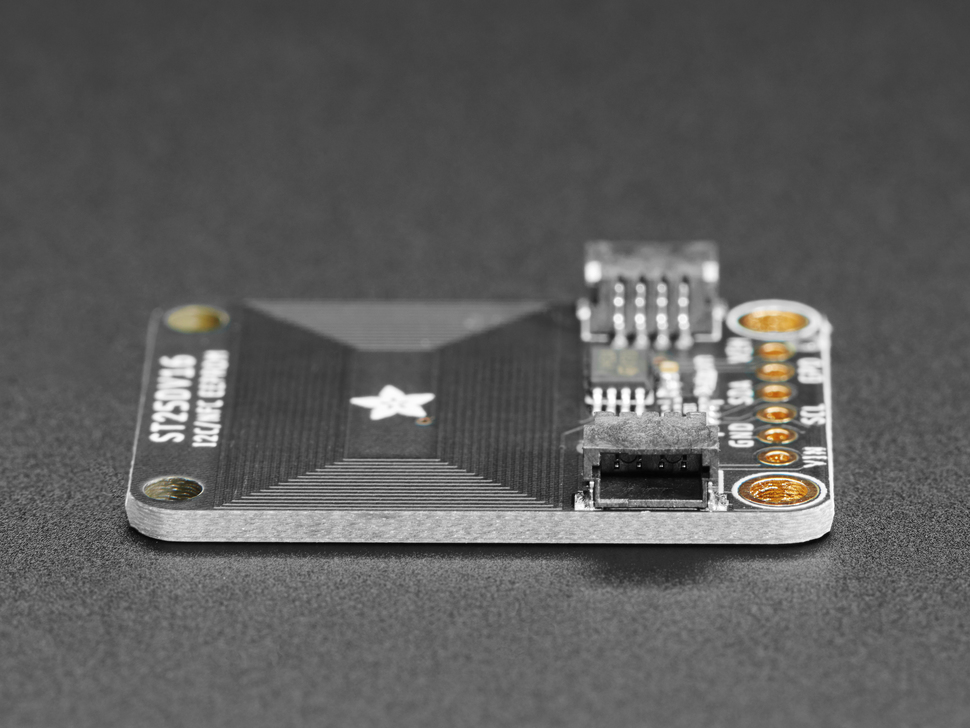Adafruit ST25DV16K I2C RFID EEPROM Breakout – STEMMA QT / Qwiic
2.60 د.ك
Out of stock
Description
DESCRIPTION
This RFID tag is really unique: it works with mobile phones just like other RFID tags, but you can reprogram it over I2C. The tag shows up as an ISO/IEC 15693 (13.56MHz) chip which is readable by phones and tablets. This could be interesting in situations where you want a tag that can be re-written dynamically when connected to a controller. For example, we did a test where we had a microcontroller write different URLs a few seconds apart, and the mobile phone detected the different URLs one after the other.
Note that the most popular hobby RFID reader/writer chips like the PN532 do not support ISO15693 so you cannot use those to read the ST25DV tag once programmed! We used both Apple and Android phones with success to read the tags.
According to the datasheet, one can even use it as an ‘I2C to RFID’ transfer system to wirelessly send and receive data from mobile devices (you’ll need to write a custom app for that kind of project, though).
ST has written a handy library that you can easily use to write NFC URLs to the chip over I2C. You cannot use an Arduino UNO (ATmega328p) with the ST25DV library, there’s not enough RAM. Please use a Metro M0 or other SAMD chip (or better) to communicate with the ST25DV. There’s no Python or CircuitPython library for this chip at this time, only Arduino.
To make connections easy, our breakout contains an ST25DV04 chip, support circuitry and even a PCB trace antenna. There’s standard 0.100”/ 2.54mm pitch headers for use with a breadboard. Should you wish to avoid soldering, the breakout also includes our Stemma QT connectors (SparkFun Qwiic compatible). Using these handy connectors you can simply plug in the sensor and get rolling with your project. QT Cable is not included, but we have a variety in the shop
TECHNICAL DETAILS
I2C interface
- Two-wire I2C serial interface supports 1MHz protocol
- Uses multiple I2C addresses 0x2D, 0x53 (user memory) and 0x57 (system memory)
- Single supply voltage: 1.8V to 5.5V
- Multiple byte write programming (up to 256 bytes)
Contactless interface
- Based on ISO/IEC 15693
- NFC Forum Type 5 tag certified by the NFC Forum
- Supports all ISO/IEC 15693 modulations, coding, sub-carrier modes and data rates
- Custom fast read access up to 53 Kbit/s
- Single and multiple blocks read (same for Extended commands)
- Single and multiple blocks write (up to 4) (same for Extended commands)
- Internal tuning capacitance: 28.5 pF
Memory
- 16-kbits of EEPROM
- I2C interface accesses bytes
- RF interface accesses blocks of 4 bytes
- Write time:
- From I2C: typical 5ms for 1 byte
- From RF: typical 5ms for 1 block
- Data retention: 40 years
- Write cycles endurance:
- 1 million write cycles at 25 °C
- 600k write cycles at 85 °C
- 500k write cycles at 105 °C
- 400k write cycles at 125 °C
Fast transfer mode
- Fast data transfer between I2C and RF interfaces
- Half-duplex 256-byte dedicated buffer
Energy harvesting
- Analog output pin to power external components
Data protection
- User memory: 1 to 4 configurable areas, protectable in read and/or write by three 64-bit passwords in RF and one 64-bit password in I2C
- System configuration: protected in write by a 64-bit password in RF and a 64-bit password in I2C
Product Dimensions: 31.7mm x 25.3mm x 4.6mm / 1.2″ x 1.0″ x 0.2″









